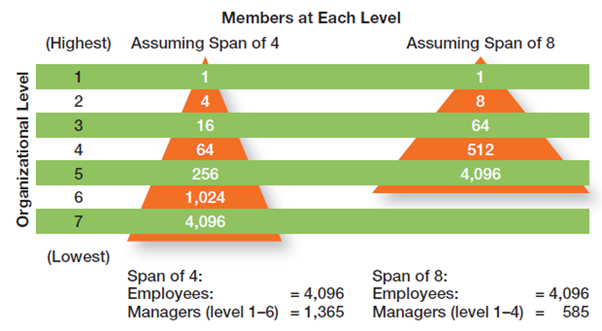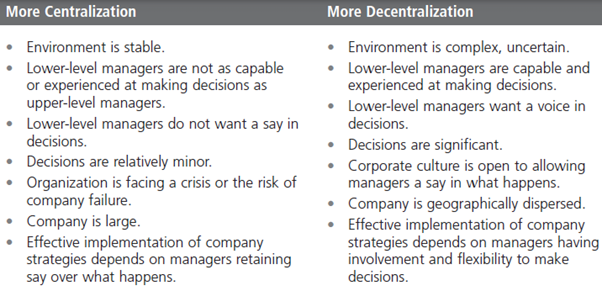
Chapter Outline
· Designing Organizational Culture:
· Mechanistic and Organic Structures:
· Contingency Factors Affecting Structure Choice:
· Traditional Organizational Designs:
Managers are now re-evaluating and considering new approaches to find new structural designs that best facilitates and supports employees work in the organization. Such designs, to achieve efficiency and more flexible.
A healthy work environment is a mix of structured, mundane and disciplined with full of emotions and high level of risks. The work gets efficiently and effectively in healthy environment.
· Organizing:
It is a process of arranging and structuring work to achieve organizational goals.
· Organizational Structure:
It is a formal arrangement of jobs within the organization.
· Organizational Chart:

· Organizational Design:
When manager create or change organizational structure, he is involved in organizational design. It involves decisions about six key elements which are:
Ø Work Specialization
Ø Departmentalization
Ø Chain of Command
Ø Span of Control
Ø Centralization and decentralization
Ø Formalization
Work Specialization:
It is to divide work activities into separate job tasks. The workers are expert in performing part of activity rather than the entire activity. It increases work output.
Ø Workplace specialization makes efficient use of workforce diversity.
Ø In an organization some tasks need specialized skills and some tasks don’t need expertise.
Ø Pay scale varies. On who is performing more technical or sensitive task gets higher salary than the one who is performing ordinary job.
Today’ View:
Managers today find work specialization as important as it help employees to become more efficient.
Departmentalization:
Jobs are grouped in different groups which is called as departmentalization.
Specific departments are responsible to perform and complete different tasks. Different departments can be sales department, accounts department, operations department etc.
Today’s view:
Organizations use various forms of departmentalization.
A department which is becoming the must have need of organization is “customer department”. As it is important for companies to know what customer think about their products and take their feedback. And to know the changing tastes etc.
· Cross-Functional Team:
A team which is composed of employees from different functional specialties.
Departmentalization can be of following types; some examples are mentioned below.





Chain of Command:
It tells about who reports to whom. It is line of authority comes from upper level to lower level of organization.
· Authority:
Rights inherent with the managerial position to tell employees what to do and to expect them to do it. Authority delegates downward to lower-level managers, of-course with some limitations
Early management writers take it as glue which holds the organization together. They told authority is related with one’s position in the organization.
Acceptance Theory of Authority:
Management writer “Chester Barnard” proposed this theory as, the willingness of subordinates to accept the authority of manager. Barnard further tell the four conditions when subordinates will accept the authority or order from manager. These conditions are:
Ø Subordinates understand the order.
Ø They find the order as consistent with organization’ purpose.
Ø Order don’t pose any conflict with their personal beliefs.
Ø They have ability to perform the given task.
Line Authority:
Authority travels from top level to lower level of company.
The manager, who direct the work of an employee. Oversee the work of employees working under his command and report to senior manager or president or CEO of company. Who reports to whom, depends on the hierarchy in the company.
Staff Authority:
When line manager gets over burden or don’t have the expertise of technical matters, then they hire a staff manager, who is expert in specific field. For example; the administrator of some hospital hires a procurement manager in the purchase department.

· Responsibility:
When employees receive order from manager to perform a duty. It becomes their responsibility to perform that duty honestly and in most appropriate way.
Employee should be held accountable for his performance.
· Unity of Command:
Unity of command is to say, employee should report only one boss. If he will be held responsible to report more than one manager, then demands from both managers will vary which will result in conflicts.
Today’ View:
Ø In today’s world of rapid change, most companies don’t get involved in these above-mentioned authorities.
Ø The concept of authority is changing. Now employees resolve issues through “in house meetings” as they think consulting with senior manger or manger will take time, which they cannot afford.
Ø Companies who are running more than one project, in such companies, employees often have to report more than one boss.
Ø Now employees can communicate with anyone in the company with the use of modern communication tools. Which is against the concept of line authority or chain of command.
Span of Control:
How many employees a manager can manage effectively and efficiently. As per a traditional view, a manager should not supervise more than five or six subordinates.
It determines the number of levels and managers in an organization. The larger or wider the span, the more efficient an organization is.
But sometimes wider span is not really efficient, if manager is unable to answer the call of his subordinates.

Today’s View:
The contemporary view says, there is no limit of maximum numbers in a span. Wider spans reduce costs. Following are the factors:
Ø Skills and abilities of manager, characteristics of employees and nature of work to be done.
Ø Having well trained and experienced subordinates, managers can manage wider span.
Ø Similarity and complexity of employee’ tasks.
Ø The sophistication of company’ information system, organization’ culture, and preferred style of manager
Centralization and Decentralization:
When decision making takes place at top level of organization and very little input is taken from lower level of staff, then the organization is Centralized.
Vice versa, if more of input is taken from lower-level staff and in-fact they take decisions, then the organization is Decentralized.
Earlier management writers focused on centralization, and organizational structure was made in a way that more decision-making power was with top level employees.
But now, as organizational operations are getting more complex, and timelines are running short, so quick decision making is required. For this major reason, organizations are becoming decentralized and decisions are made by the most relevant person of the field.
Today’s view:
An organization can never be fully centralized or decentralized.
Current situation and nature of work determine, whether organizations should be centralized or decentralized.
· Employee Empowerment:
This shift from centralization to decentralization, have empowered employees. Lower-level employees have the authority to make decisions which favors the situation and in the best interest of organization.

Formalization:
Formalization in a company simply means, the rules and regulations of the company, tasks are defined, clearer job descriptions etc.
If formalization is high in an organization, then there is less discretion of employee over, what’s done, when it’s done and how it’s done.
Vice versa, if formalization is low then employees have more discretion in how they do their work.
Today’s view:
Today companies go with mix match approach, depending upon the circumstances, they allow employees to go beyond the line if the action is in the favor of company. For example, employees doing something to satisfy customer.
But still there are some matters, in which companies don’t show relaxation. Strict policies are there and employees are supposed to follow them. For example, strict policies are made about an employee should respect other gender, regardless of male or female.
With the passage of time, restructuring or redesigning organization’ structure is important. Organizational designs revolve around two organizational forms, which are mechanistic organizations and organic organizations.
Mechanistic Organizations:

Mechanistic organizations are hierarchical, every employee is controlled and supervised by someone, so organizations grow tall.
As there is big gap between top managers and low-level staff, so rigid formal rules and regulations are there to watch over them.
Spans of control are kept small.
For each function there is a specific department, who have a manager. And strict rules are there.
Organic Organizations:

Organic organizations are less formal and more adaptive.
Tasks are not standardized, and employees know well what is expected from them, they are fully trained to respond any problem they face.
They need very little formal rules and code of conducts, they know how to behave and how to tackle situation in different times.
As these organizations are not centralized, so relevant employees can make decisions to solve different problems.
While changing organizational structure, there are four contingency variables, which are; Strategy and structure, Size and Structure, Technology and structure, Environmental Uncertainty and structure.
Strategy and Structure:
Alfred Chandler studies this relationship, his studies find that, a change in strategy leads to change in organizational structure. As goal achievement is an integral part of strategy, and organizational structure should support goal achievement. So, it can easily be concluded that, strategy and structure are closely linked with each other.
Flexibility and free flowing of information works well with organic firms who encourage innovation.
Strict rules work well with mechanistic organization, who want to control costs.
Size and Structure:
Size of organization effects its structure.
Organizations with more than 2000 employees are considered as large, they ill have more specialization, departmentalization and mechanistic approach. If we add more 500 employees, this increase in size will not affect an organization because it is already large.
But if we add 500 employees to organization who already have 300 employees, in this case, this increase in size will affect the structure of organization. An it will have to adopt mechanistic approach.
Technology and Structure:
Every organization use technology to convert its inputs into outputs. Organizations adopt one of the following mentioned methods of production, as per their need.
· Unit production:
Production of products in units or in batches.
· Mass Production:
Mass production means bulk production or in large quantity.
· Process Production:
It is continuous process production. Every step involves technological touch.
Environmental Uncertainty:
Some organizations face stable and simple environment, these organizations have the mechanistic organizational structure.
While on the other hand, organizations face uncertain and challenging environment, these organizations need to adopt organic organizational structure, because it offers flexibility.
Today’s View:
Today organizations are getting more organic to compete in today’ uncertain and challenging environment and to satisfy customers. Mechanistic approach often fails to respond the rapid changes.
While designing a structure, managers may choose one of the following traditional organizational designs. These are often mechanistic in nature.
Simple Structure:
Most companies start with this simple structure, as there are less number of employees, so no formal rules, specializations, and departmentalization. Decision making is often in the hands of one person and wide span of controls.
Strengths: it’s fast, easy to maintain, flexible and clear accountability.
Weaknesses: it is not sustainable and long term, as organizations grow, so managers have to adopt another organizational design. And company cannot rely on one person’ decisions and thoughts.
Functional Structure:
In this type of design similar or related jobs are grouped together. And making departments for related functions.
Strengths: cost saving advantage through economies of scale, minimal duplication of people for same tasks.
Weaknesses: while attaining functional goals, managers often fail to recognize what is best for organization overall and they don’t know what is happening in other functional groups.
Divisional Structure:
In divisional structure, separate business units are made. Each have its own manager who is responsible for the results. The parent corporation often provide overseeing and support services.
Strengths: Focus on results, as divisional manager is responsible for its services and products.
Weaknesses: there is a chance of duplication of activities and resources, which will increase costs and reduce efficiency.